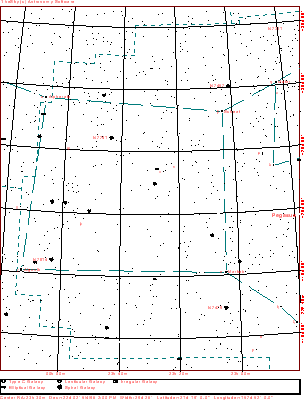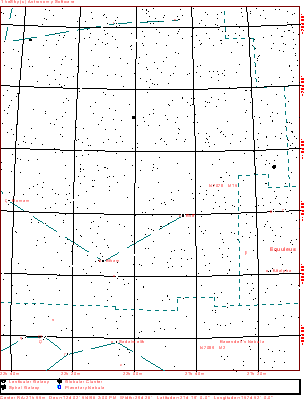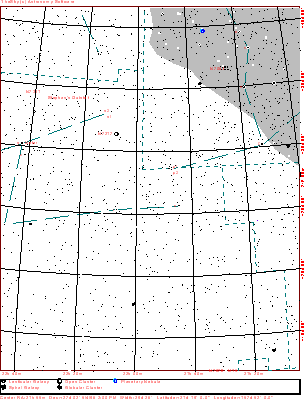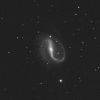
| Home | Deepsky Atlas | TheAstronews | Links | Solar System | ||||||

Hawaiian Astronomical SocietyConstellations: Pegasus -- The Medusa's "Child" |
||||||||||

Click the map for a 916x1200 version of the above. Click here for a map better suited for use in the field.

This a more detailed view of the constellation. The map displays stars to magnitude 10, and deepsky objects to magnitude 12. Click here for a map better suited for use in the field.

Click here for a map better suited for use in the field.

Click here for a map better suited for use in the field.
 38k JPEG.Photographer's notes: Five exposures of NGC7331 (Best 78, Caldwell 30), each of ten minutes, were combined in MiPS to bring out much detail, particularly the 'cotton wool' structures in the spiral arms. 38k JPEG.Photographer's notes: Five exposures of NGC7331 (Best 78, Caldwell 30), each of ten minutes, were combined in MiPS to bring out much detail, particularly the 'cotton wool' structures in the spiral arms.
Located 4° NNW of Matar, NGC7331 is a fairly bright (mag. 9.5), elongated (position angle 163°), galaxy that brightens considerably toward the middle. The "cotton wool" mentioned above is just visible in a good 8".
|
 450k JPEG This image contains NGC7331 and five other galaxies collectively called Stephan's Quintet, located .5° to the SSW. 6" telescopes from a dark site might glimpse a dim fuzzy patch that appears mottled with averted vision. An 8-10" telescope distinguishes 4 of the five galaxies. Larger telescopes are needed to split NGC7318 into its two components. The galaxies range from mags. 14-14.8. All range between 1-2' in size. Images from the Digital Sky Survey. 450k JPEG This image contains NGC7331 and five other galaxies collectively called Stephan's Quintet, located .5° to the SSW. 6" telescopes from a dark site might glimpse a dim fuzzy patch that appears mottled with averted vision. An 8-10" telescope distinguishes 4 of the five galaxies. Larger telescopes are needed to split NGC7318 into its two components. The galaxies range from mags. 14-14.8. All range between 1-2' in size. Images from the Digital Sky Survey.
|
 9k JPEG Located 2.5° WNW of Algenib (Gamma Pegasi) in the Great Square, Caldwell 43 (NGC7814) is a quite large (5'x2.5'), quite bright (mag. 10.5), elongated, edge on spiral galaxy with a not too pronounced core. Large scopes might spot the central dust lane. 9k JPEG Located 2.5° WNW of Algenib (Gamma Pegasi) in the Great Square, Caldwell 43 (NGC7814) is a quite large (5'x2.5'), quite bright (mag. 10.5), elongated, edge on spiral galaxy with a not too pronounced core. Large scopes might spot the central dust lane.
|
 29k JPEG Caldwell 44 (NGC7479) is a barred spiral galaxy located 2.7° south of Markab (Alpha Pegasi). Dreyer calls it quite large (4'x3.3'), fairly bright (mag. 11), much elongated (PA 25°). Amateurs will see the galaxy sitting between two stars. 29k JPEG Caldwell 44 (NGC7479) is a barred spiral galaxy located 2.7° south of Markab (Alpha Pegasi). Dreyer calls it quite large (4'x3.3'), fairly bright (mag. 11), much elongated (PA 25°). Amateurs will see the galaxy sitting between two stars.
|
 102k JPEG M15 (NGC7078) is a fine, powdery globular cluster located 4.2° NW of the mag. 2.1 star Enif (Epsilon Pegasi). Dreyer calls it very bright (mag. 6.4), very large (12'), irregular, and highly condensed. A 6" telescope is needed to resolve individual stars easily. Obviously a Hubble Space Telescope image. 102k JPEG M15 (NGC7078) is a fine, powdery globular cluster located 4.2° NW of the mag. 2.1 star Enif (Epsilon Pegasi). Dreyer calls it very bright (mag. 6.4), very large (12'), irregular, and highly condensed. A 6" telescope is needed to resolve individual stars easily. Obviously a Hubble Space Telescope image.
|
If you have any questions about the Hawaiian Astronomical Society
please
(link requires javascript).